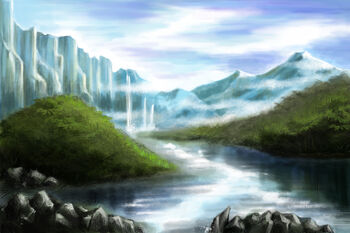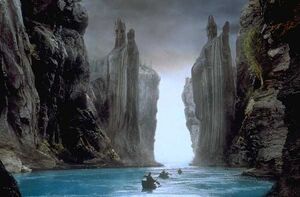
|
"It's not ready yet." "Ready for what?" "Reading." The majority of this article, or particular section, is below the wiki's standards; please rewrite and improve. |

The Anduin river, by Vigshane

Map of the Anduin within Middle-earth.
For other uses of The Great River see: The Great River (disambiguation)
Anduin was the Sindarin name for the Great River of Wilderland, also known as The Great River, and to Éothéod, the ancestors of the Rohirrim, as the Langflood.
Length and location
Anduin was the longest river in the Third Age. In The Atlas of Middle-earth, Karen Wynn Fonstad estimates a total length of 1,388 miles (approximately 2,234 kilometers). The original Sindarin name means "Long River".
It flowed from its source in the Grey and Misty Mountains to the Mouths of Anduin in the Great Sea (Belegaer).[1]
Source
The Anduin began as two different streams near where the Misty Mountains met the Grey Mountains. These were called the Langwell and the Greylin by the Éothéod when they lived in the triangle of land formed by it. Their old capital, Framsburg, was built at the confluence of these streams where the Anduin proper began. The Langwell had its source in the Misty Mountains, close to Mount Gundabad, and the Greylin began in the westernmost heights of the Grey Mountains.[1]
Course
The Anduin flowed parallel to the Misty Mountains in a broad vale which formed the western part of Rhovanion, lying between the mountains and Mirkwood. After passing Lórien, the river farewelled the mountains and flowed through the Brown Lands (which may have been home to the Entwives) via the North Undeep and South Undeeps until it flowed past the Emyn Muil and the Argonath and entered a lake (Nen Hithoel) through Sarn Gebir (a series of ferocious rapids). Thence it flowed over the Falls of Rauros and past the Mouths of Entwash and the marshes known as the Wetwang. It then passed between the White Mountains and the Mountains of Shadow by the capital of Gondor, Osgiliath, before swinging past the harbour of Harlond close to the Rammas Echor south of Minas Tirith (Barbara Strachey, in Journeys of Frodo, places the harbour just outside the wall), and the Emyn Arnen and down past the port of Pelargir, entering the Great Sea in the Bay of Belfalas in a broad delta known as the Mouths of Anduin.[1]
Tributaries
In order from north to south: the Rushdown, the Gladden which joined at the marshes known as the Gladden Fields, the Celebrant, the River Limlight, the Entwash, the Morgulduin, the Erui, the Sirith and the Poros. The first five had their sources in the Misty Mountains, the Morgulduin and (presumably) the Poros in the Ephel Dúath on the border of Mordor, and the rest in the White Mountains.[1]
Crossing points
The Old Forest Road which led from the High Pass into Mirkwood crossed the river at the Old Ford, to the south of Beorn's Halls.
There were bridges in the city of Osgiliath, broken by the forces of Gondor to halt the armies of Mordor in the War of the Ring, but later partly repaired by Mordor.
Other crossing points appear to be somewhere near the Wold, and have been of immense strategic importance to both Sauron and his enemies. These crossing points have been tainted with the blood of thousands either attempting to defend or attack it, as seen several times during the early-mid Third Age. In TA 490 a large force of Easterlings crossed the Anduin and proceeded to attack Gondor.
In TA 1248 Romendacil II and his Gondor army forded these same crossings to end the incursions of the Easterlings into Rhovanion. The Men of Rhûn were utterly crushed and the vengeful men of Gondor razed innumerable Rhunic settlements in and around the Sea of Rhûn to ash.
However, bloody Easterling revenge was about to arrive upon the Men of Gondor. In TA 1856, the Wainriders attacked en masse, swiftly overrunning all of the dearly-bought Gondor gains east of the Anduin. When King Narmacil II and his army arrived in the Brown Lands south of the eaves of Mirkwood, the Easterlings' aptitude in utilizing chariots on the open plains to flank and scythe down the slow-moving Gondor infantrymen proved decisive. The king was slain and the Easterlings retook all of Gondor's possessions and protectorates east of the Anduin, save for Ithilien on the doorstep of Mordor.
However, the losses inflicted upon the Wainriders by the stalwart Men of Gondor proved decisive. Their leaders felt that they needed to rest and recuperate, before dealing the coup-de-grace to the ailing corpse of Gondor. This bought crucial time for Gondor to revive its military strength and shift soldiers to the northern provinces, where many knew that the Easterlings would strike next. The next target was the northern province of Calenardhon and all knew its immense strategic importance; the battle for the fate of Middle-earth was about to begin.
Countless other battles were fought over the Anduin, and surprisingly, both sides in the War of the Ring neglected its immeasurable importance. A strike by the Easterlings over the Anduin, while the entire army of Rohan was away fighting on the Pelennor Fields, could've proved decisive and would've spelled the end of Rohan and Gondor alike. Likewise, a swift Rohirrim strike, with enough strength and adequate tactics, could have easily flanked Sauron's vast armies near Mordor and cost the Dark Lord dearly for no gain.[citation needed]

The Argonath, a memorial to Isildur and Anarion on the river, at the opening of Nen Hithoel
Settlements
During the March of the Elves in the Time of the Trees, the Nandor left the Eldarin host when faced with the great heights of the Misty Mountains, and lived in the Vales of Anduin. Some of those people later left and became the Green-elves of Ossiriand, but Elves remained present even until the time of the War of the Ring, strengthen by refugees from Beleriand (at the end of the First Age) and Eregion (during the Second).
Settlements in the Vales of Anduin during the Third Age included the Northman city of Framsburg, Beorn's Halls, and the Stoor settlements near the Gladden Fields (where Sméagol/Gollum) was born. It was in the Gladden Fields in the northern reaches of Anduin that Isildur was slain and the One Ring lost; and it was there, more than two millennia later, that Déagol found the Ring and Sméagol took it from him. Rhosgobel, home of Radagast the Brown, and the Elven Realm of Lothlórien also lay in the Vale of Anduin.
Once it had entered Gondor, the river flowed past Osgiliath and Minas Tirith and then Pelargir, close to the sea. After the fall of Osgiliath the river effectively marked the eastern limit of Gondor's influence.
Islands
The principal islands appear to have been Cair Andros, on the borders of Ithilien and Tol Brandir in Nen Hithoel. Carrock, in the north, was where the eagles deposited Thorin and Company. There was also an eyot, where the Fellowship rested during their travel between Lórien and Parth Galen.
Etymology
Anduin is a Sindarin word that meant "Long river" or "great river".[2]
| Nunduinë • Siril | |
| Glanduin • Gwathló • Hoarwell • Lune • Sirannon • Withywindle | |
| Anduin • Celebrant • Forest River • Gladden • Greylin • Langwell • Limlight • Nimrodel • Redwater • River Running | |
| Anduin • Ciril • Erui • Gilrain • Harnen • Lefnui • Mering Stream • Morgulduin • Poros • Ringló • Serni | |
| Adorn • Entwash • Isen • Mering Stream • Snowbourn | |
| Brandywine River • Shire-water • Shirebourn | |
| Adurant • Ascar • Brilthor • Duilwen • Gelion • Legolin • Little Gelion • Thalos | |
| Aros • Dry River • Esgalduin • Mindeb • Narog • Rivil • Taeglin | |
| Brithon • Celebros • Celon • Malduin • Nenning • Ringwil • Sirion | |
Translations around the world
| Foreign Language | Translated name |
|---|---|
| Amharic | ዓንዱኢን |
| Arabic | إندوين |
| Armenian | Անդուին |
| Belarusian | Андуін |
| Bulgarian | Андуин |
| Catalan | Ànduin |
| Chinese (Hong Kong) | 安都因河 |
| Czech | Anduina |
| Dari | اندوین |
| Georgian | ანდუინ |
| Greek | Άντουιν |
| Gujarati | આન્દુઇન |
| Hebrew | האנדוין ? |
| Hindi | आन्दुइन् |
| Hungarian | Hosszú-folyó |
| Kazakh | Андұін |
| Kurdish | ئاندوين |
| Kyrgyz | Андуин |
| Macedonian | Андуин |
| Mongolian | Андуин |
| Pashto | اندُِن |
| Persian | آندوین |
| Polish | Anduina |
| Russian | Андуин |
| Tajik | Андуин |
| Tigrinya | ዓንዱኢን |
| Sanskrit | आन्दुइन् |
| Ukrainian | Андуін |
| Urdu | اندوان |
| Uyghur | ئندۇىن |
| Uzbek | Андуин (Cyrillic) Anduin (Latinised) |
| Yiddish | אַנדוין ? |
References
- ↑ 1.0 1.1 1.2 1.3 The Atlas of Middle-earth, Regional Maps, "Wilderland"
- ↑ The Complete Guide to Middle-earth
